Stuart Perry enjoyed driving RFs on the 210 whilst at Muswell
Hill (MH) in the 1960s, but also worked on RTs and RMs. He
writes:
Route 210
I arrived at MH garage in the autumn of 1963 having passed
through the Chiswick training school on the RTW. Until mid 1963 the
210 was the exclusive domain of the senior drivers and there was no
chance for any newcomers to work the route. Then suddenly
everything changed with the arrival of the RM for the 43 and later
the 134. The senior drivers were attracted away from the 210 by the
prospect of power-assisted steering and automatic transmission.

Well-loaded RF430 in original condition takes
the tight turn at Jack Straws Castle before dropping down from
Hampstead Heath to Golders Green.
Photo Eamonn Kentell collection
So the 210 was opened up to anyone who asked for a transfer. My
application was accepted and I began driving on the 210 early in
1964.
On the 210 page, you mention type
training when the RF was first introduced. I can't comment on
that, but I can tell you what happened to new recruits to
MH. You left Chiswick with your PSV Badge and a type training
certificate. Mine allowed me to drive the RT (including RTL and
RTW) and RM. For the first couple of weeks at the garage you
were on the spare rota. Basically the allocation staff could give
you any job they chose on a daily basis. I was then called into the
Office and told I would be on 2 hours RF training the next day.
There were two RF's working the peaks only.
A gold badge inspector gave me one of these buses around midday and
said we were off to Leyton. The idea was you got the type training
and the route learning as one package. So basically that was
it. The controls were similar to the RT and after the trip to
Leyton, if you didn't hit anything you were told you had been
passed fit to drive the RF. Presumably when the RF was first
introduced, each driver got 2 hours.
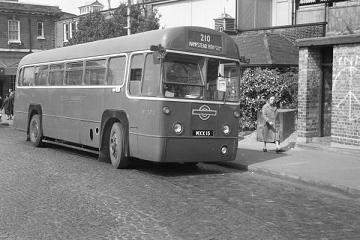
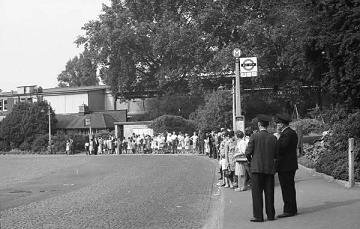
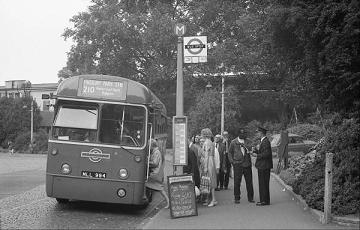
This sequence by
Mike Beamish
shows RF373 laying over at Golders Green before running a short to
Hampstead Heath Jack Straws Castle. Mike explains
that the fair on Hampstead Heath at Bank Holidays generated a great
deal of extra traffic, for which these 'swingers' were
operated. The second picture shows the queues that could
build up, then RF357 loads up. The notcie reads '? Monday -
Route 210. Please queue other side of stop'.
Photos © Mike Beamish
The 210 was unusual in that it was busier on Saturdays and
Sundays than during the week. There was no real peak hour surge.
Nine RFs covered the route all day, only increasing to eleven in
the peak hours. The Sat and Sun requirement increased from 11 to
12.
Late running was unheard of except on bright summer Sundays and
Bank Holidays when traffic could be gridlocked across Hampstead
Heath particularly between Jack Straws Castle and the Spaniards
Inn. On Sundays the route absorbed the 236 to Leyton. The
inspectors at Golders Green would normally let the through services
continue as there was ample opportunity to make up lost time at the
eastern end of the route especially across Hackney Marshes. Buses
scheduled to short work to Finsbury Park were curtailed at Archway
to regain time.
The shot of RF486 at the Spaniards reminded me that we had an
eccentric old lady who boarded at The Bishops Avenue request stop
always in the direction of Golders Green. We always called it
Millionaires Row. I have never pretended to be an expert on ladies
fashion but even I could tell that her clothes were very expensive
designer style and my Conductor told me that when she opened her
purse to pay it was jammed full with £5 notes. On reaching Golders
Green she would always give the crew a twenty packet of Capstan
Full Strength. We also picked her up for the return journey but
never any fags!!
The 210 rota was always full for Conductors even when staff
shortages were at their worst. The advantages were no stairs to
negotiate (not an insignificant consideration),
the opportunity to gossip with the driver and considerably
less responsibility for the bell. As a result many of the 210
crews were married couples. I was one of the
exceptions. It also has to be remembered that crew work on
the RF was at the same rate of pay so not really surprising that
the Conductors loved to work on them.
It is very nostalgic to see in Mike Beamish's photo the checkers fretting about the queues for the 210.
We were very much left alone Mondays to Saturdays to run the
service They were far too busy sorting out late running on
the 2 and 13 but on Sundays we got all the attention. I was never
asked to do a short to Jack Straws Castle but it was very common to
be asked to do a short to Archway losing the section from there to
Finsbury Park. The problem then was that there were service gaps at
Wells Terrace. I remember once customers complaining that
there had been no 210 for 45 minutes. The checker at Wells Terrace
was trying to tell them, rather stupidly I thought, that they
should have waited round the corner and picked up one of the buses
running through from Leyton - I doubt if they even knew about
the through service. There was talk in the garage at one stage that
the buses running through from Leyton should do a complete circuit
around Finsbury Park to cover the terminus stop in Wells Terrace
but nothing came of it. This was one of those situations
where you just couldn't win.
At the other end of the year, in snowy conditions, there
was a permanent instruction on the garage notice board that in bad
conditions you had to engage 2nd gear at Highgate Village and
descend all the way to Archway under compression. Also, at
the driver's discretion, you could ignore the request stops both up
and down situated half way up the hill. There was also a
similar instruction to descend Muswell Hill in 2nd gear on the
212.
Reading the article by Pat Spencer on
driving the 236, he mentions that we (MH crews) didn't like the
route, but it was a bit more complicated than that. For some reason
LT refused to sanction PAID route learning for us over the 236 road
[presumably unless it happened to be covered in type-training, as
it was with Stuart] and you had to route learn in your own time.
This didn't go down well as you can imagine and the more militant
drivers refused to do the Sunday duties on the rota and the
allocation staff had to check that drivers signed in for the Leyton
journeys actually knew the road. I was one of those who rode the
route in my spare time as I thought the journeys to Leyton would
add a bit of variety. I would love to know what arrangements
were put in place for T and AR drivers to route learn the 210.
Garage journeys on the 210 between MH and Archway Station were
run in service. If the first destination was Finsbury Park then the
route was via Highgate Station. If the first destination was
Golders Green then the route was via Crouch End Broadway and
Hornsey Rise. In practice very few people used the service mainly I
think because the public were bemused by the fact that the buses
reached Archway by two completely different routes.
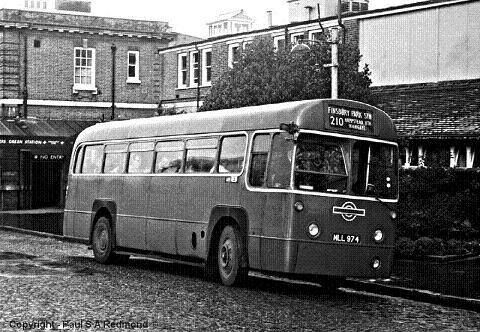 In the autumn of 1964 there was a problem with poor
performance by some of the RFs and the garage TGWU rep asked us to
keep records of the buses we drove. The garage allocation at the
time was 12 and I drove all but one of them during the time of the
survey: 337, 354, 383, 434, 441, 453, 454, 462, 475, 480, 500. For
the record my list shows 441 and 500 were the star performers at
the time. 337 and 454 were the only two I complained about. The
records do not show 383 as allocated to MH, but I do remember that
at the time there was one regular bus carrying a metal MH plate
covering the painted allocation. I don’t know the reason for the
long term loan as otherwise the correct number of buses appear to
have been in the garage. The increased Sat and Sun requirement from
11 to 12 meaning no spare might have been the reason.
In the autumn of 1964 there was a problem with poor
performance by some of the RFs and the garage TGWU rep asked us to
keep records of the buses we drove. The garage allocation at the
time was 12 and I drove all but one of them during the time of the
survey: 337, 354, 383, 434, 441, 453, 454, 462, 475, 480, 500. For
the record my list shows 441 and 500 were the star performers at
the time. 337 and 454 were the only two I complained about. The
records do not show 383 as allocated to MH, but I do remember that
at the time there was one regular bus carrying a metal MH plate
covering the painted allocation. I don’t know the reason for the
long term loan as otherwise the correct number of buses appear to
have been in the garage. The increased Sat and Sun requirement from
11 to 12 meaning no spare might have been the reason.
Poor performer RF337, also at Golders
Green.
Photo © Paul Redmond
The problem was a local one affecting MH. The busiest
section of route was the ascent of Highgate Hill. For some reason
the locals seemed to prefer the RM-operated 271, which was fine by
us, but if that route had suffered a service gap you could end
up with a standing load leaving Archway. Some of the drivers
complained that certain RFs wouldn't deal with the hill without
using 1st gear. This only happened to me once with 454 which was a
very poor bus anyway. Things did eventually improve when a big
cheese from Chiswick arrived without warning, test drove the three
worst buses, read the riot act and the maintenance was
tightened up.
The other bit of trivia from my notes is about 475. The steering
wheel on the RF was slightly larger than the RT and I was a bit
surprised that 475 had an RT type steering wheel. I had forgotten
about it until I did a piece of overtime on the 212 and was given
RT 814 which had the RF steering wheel. Obviously they had at some
time been on the pits together and someone hadn't put the bits back
together properly. Whoops! A few furrowed brows I expect at
Aldenham when 475 went for it's next overhaul.
[Stuart has commented on the variation in performance of the RFs
he drove, as compared with relatively uniform RTs and RMs,
and added notes on the individual buses - see here.]
I enjoyed the opportunity to work as a team with the conductor
which the front step access allowed and when working any overtime
on the garage's other routes I actually found the bell
irritating. I have many fond memories of the 210 but have to
confess that eventually I too caved in for the comfort of the RM
and transferred onto the 43 rota.
In 2009, I met Phil Wilsher, an old 210 stalwart, who was proud
to tell me he had just enjoyed his ninetieth birthday but still
very sprightly. Phil loved the 210 and although because of
his years of service was entitled to work on the quieter 251 or 244
he always stuck to the 210 right to the end. He told me he
remembers driving the TD and Q types alongside the RF in the
transitional period when it was pot luck whether your duty would be
on the then brand new RF or perhaps half and half. He also
told me that after 1963 he tried to get duty exchanges on Sundays
as he couldn't get used to the 236 road to Leyton.
Staff buses
The other use for the RF was on the night staff bus. At the peak, the requirement
increased from 9 to 11. The two buses working the peak hours only
were MH5 and MH9. The first bus back in the garage in the evening
was MH5 and this was automatically parked on the forecourt and
became the night staff bus. After that duty the driver would leave
it in the rear yard ready to be out again at 0400 for the
early morning staff bus. On return it was driven onto the
pumps, refuelled, and then became MH11, i.e. the last bus out from
the garage on the 210.
As the staff bus driver, you left the garage at 0045 or when the
last conductor had paid in. The route was Muswell Hill Broadway,
Highgate Station, Archway Station, Holloway Road (pick up J crews),
Nags Head, Hornsey Rise, Crouch End Broadway, Turnpike Lane
Station, Great Cambridge Road, Ponders End (pick up E crews). Then
depending who was left on the bus and where they wanted to be
dropped off, return to MH garage. The route was worked in the
opposite direction in the morning, departing MH garage at 0400.
At night, timing was not
important as your job was simply to get everyone home as quickly as
possible, but it was a different matter in the early mornings.
There could be up to twenty or thirty crew members dotted
along the line of route and they were totally relying on you to get
to work on time. If you messed up then the early morning run
out was wrecked. My strategy was to run about 2-3
minutes late to give everybody the best chance, as far as
Muswell Hill Broadway and then speed down the hill to the
garage arriving just about on time.
We were supposed to display the
"Private" blind when operating the Staff Bus, but I usually
showed Totteridge Common 251 just for fun. All the 251 stuff
was still on the MH RF blinds, even though the route transferred to
Edgware in February 1963, but not the 212, which went to RTs
in January 1960.
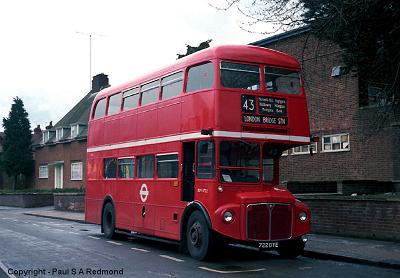 Route
43
Route
43
Each service had it own rota, and each driver and conductor had
a staff number. The 43 began at 1, the 134 at 101, the 210 at
201, the 212 at 301, and the 244 at 401.
If you were on the 210 or 212 rotas, you did nothing else except if
you chose to do overtime. The 43 rota had 134 duties on
Saturdays and 102 duties on Sundays. The 134 rota had
134A duties on Sundays and the 244 rota had some
spreadover 43 duties. By agreement with the TGWU each rota
had to have a fair mix of late, early and spreads.
In later days, RM1722 waits
on the stand before heading for the City.
Photo © Paul Redmond
Over the years, trunk route 43 between
Friern Barnet and London Bridge had become the 'blue
riband' route for MH. However, as the staff shortages in the
1960s began to bite, quite rightly in my opinion the duty
allocation staff put whatever resources were available by way of
overtime and rest day working onto the local routes 210 and 244 but
especially the 212. The result was that service gaps were common on
the 43, but like the 134 other services covered the whole
route - in particular the 104, ex trolleybus route 609, which
it duplicated from Highgate Station to Moorgate. The golden rule
was you never passed a 104 and the Finchley (FY) drivers played the
same game.
The Monday to Friday run-out was 30 RMs,
reduced to 16 on Saturday and of course no service on Sundays. The
evening service Monday to Friday reduced dramatically to 4, running
to Moorgate only. The rota was popular after introduction of the RM
and of course there were very few late turns. After midday on
Saturdays, the service only ran to City Road Windsor
Terrace in the afternoons and was withdrawn completely in the
evening.
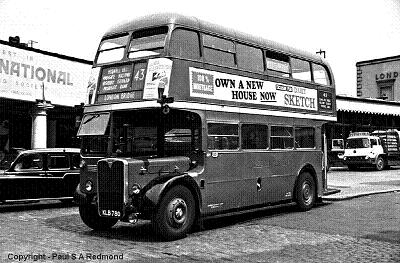 I was too
late to drive an RT on the 43, apart from one memorable afternoon.
I was working a spreadover duty and returned to the garage mid
afternoon for the second part which was two trips to London Bridge.
On arrival I was told there was no RM available. Now the rule
was that the allocation staff could ask you to take out an RT on
the 43, but couldn't insist. Walking through the garage I had
noticed RT4278 idle. I have mentioned (below) that this was
the best RT in the garage, so I said I would take an RT provided I
could have RT4278. The clerk was more than happy to agree to get
the duty covered so off we went.
I was too
late to drive an RT on the 43, apart from one memorable afternoon.
I was working a spreadover duty and returned to the garage mid
afternoon for the second part which was two trips to London Bridge.
On arrival I was told there was no RM available. Now the rule
was that the allocation staff could ask you to take out an RT on
the 43, but couldn't insist. Walking through the garage I had
noticed RT4278 idle. I have mentioned (below) that this was
the best RT in the garage, so I said I would take an RT provided I
could have RT4278. The clerk was more than happy to agree to get
the duty covered so off we went.
I picked up an RML on the 104 at Highgate Tube Station and
RT4278 had no problem punching up the RML
all the way to Moorgate. Better still on the return journey she was
so good she caught up the preceding RM on the 43 and we had an easy
ride home. I was looking forward to the second journey to London
Bridge but on reaching the crew change stop at Colney Hatch Lane
the RM I should have had was waiting, having been repaired. Sad,
but that was that and I never drove an RT on the 43 again.
Stuart only drove one RT on the 43 - RMs were
introduced in June 1963. This nice shot is of
RT2401 on the cobbles at Railway Approach, London Bridge in early
1963 (thanks to Mark Carter in Australia for recognising the
location).
Photo © Paul Redmond
As noted, the Saturday rota included the
134 but Sundays was solely on the 102, Golders Green to Chingford
(primarily worked by Palmers Green, AD). I enjoyed the 102
particularly in the summer when about one in three buses were
extended beyond Chingford to High Beach Kings Oak in
Epping Forest. There are many photographs of the famous terminus at
Chingford Royal Forest Hotel where the rule was that you
reversed onto the pub forecourt with guidance from the conductor.
In practice they had jumped off to get to the mobile canteen to get the teas in. My memory
tells me that the canteen was a Bedford articulated unit but photos
taken at the time will confirm that [it was].
Like the 134 (see below), the 43 was
all about punching up other buses which I am sure was common
practice on many duplicated sections across the whole of
LT.
If I was off duty and riding through central London I ignored
the scenery and stayed riveted to the antics of the driver. There
were of course several famous long duplications where punching up
was common. Examples were the 6 and 15 between Edgware Road
and the Bank and the 12 and 88 between Shepherds Bush Green
and Parliament Square.
All the services except the 43 had the run
out numbers you would expect, i.e. starting with MH1 as the first
bus out and then in sequence. To begin with, I couldn't work
out the 43 sequence as the first bus out was MH8 followed by MH9
and MH10. The fourth out was MH1. It suddenly dawned on
me one day that MH1 turned north to Friern Barnet. The first
three went straight to London Bridge. The running order was based
on buses leaving Friern Barnet not the garage. So in fact MH1-MH7
went first to Friern Barnet, the other 23 went straight to London
Bridge. So after MH7 had left Friern Barnet, the next departure was
MH8 which by that time had got back from it's first journey to
London Bridge. I was told later that this oddity went back many
years at least to the 1940's - the general rule seemed to be the
running order was based on the sequence of buses leaving the garage
on each route. [See the page on Running
Numbers - more examples welcome].
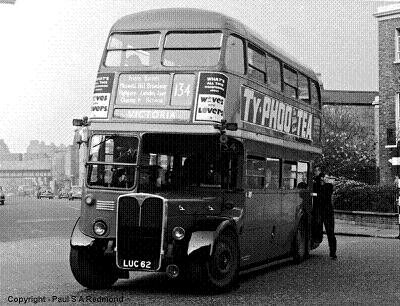
Route 134
My experiences of the 134 and 212 are
all from overtime working which was very common at the time, as the
garage like many others was suffering from staff shortages; I only
ever worked permanently on the 210 and 43 rotas.
When I arrived in 1963 the 134 was still RT
operated Monday to Friday, part RT/RM Saturdays and all RM Sundays.
The RMs came from the 43 allocation which was sparse on Saturdays
and did not run at all on Sundays.
An early shot of RT1973
working from Potters Bar on a through working to Victoria (likely
to be on a Saturday afternoon, when PB had a few through workings),
passing through Camden Town.
Photo © Paul
Redmond
At the time the route still covered the
original service Pimlico Dolphin Square to Potters Bar
Station. In practice except for some early morning and late night
journeys the route was run in two sections Pimlico or Victoria to
Friern Barnet Town Hall and Archway Station to Potters Bar
Station; MH and J (Holloway) operated the West End section and
PB operated the outer section. The route was tailor made for
the sly and artful driver as all of it between Pimlico and
Friern Barnet was covered by other services. The 24 between
Pimlico and Camden Town supplemented by the 29 from Victoria, the
27 and 137 between Camden Town and Archway and our own 43 between
there and Friern Barnet. If you positioned yourself well you
could punch up other buses all the way and believe me some drivers
did and carried light loadings all day.
There was no time clock at Pimlico
Dolphin Square so you could leave a few minutes either
side of the correct running card time. We worked it so your
conductor walked the 25 yards or so down to the next crossroads
from the terminal point from where he or she could see the 24
coming up from Grosvenor Road. You would have the engine running
and the conductor would give you the thumbs up when a 24 went
through and you then picked him or her up on the corner and knew
you had a free ride as far as Camden Town. The other scam was to
wait on the terminal loop at Friern Barnet and wait for a PB to
come through from Potters Bar, again you got a free ride as far as
Archway where most of the PB buses terminated.
There was always grumbling from the garages allocated the RTW
and RTL that they were sluggish compared to the RT. For
example, on the 19 the B crews always complained they were no match
for the J crews with the faster RT. If you were in the West
End you could see it was always the J buses punching up the B
buses. Worse still there was a rumour going round that the
engineers at J "tweaked" their RTs for even better
performance. I can confirm that on the 134 it was always hard
to hang onto a J bus unless you had one of the best MH RT's,
so I suspect there was some truth in the rumour.
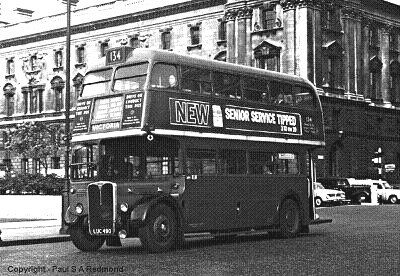 On
Sundays all journeys ran from Pimlico to Potters Bar Garage. Only
the short section to Potters Bar Station was not covered. The route
was supplemented by the 134A which ran Victoria to
Barnet Chesterfield Road deviating to cover New Barnet
Station. Interestingly that route terminated at GM garage not
the Station Forecourt.
On
Sundays all journeys ran from Pimlico to Potters Bar Garage. Only
the short section to Potters Bar Station was not covered. The route
was supplemented by the 134A which ran Victoria to
Barnet Chesterfield Road deviating to cover New Barnet
Station. Interestingly that route terminated at GM garage not
the Station Forecourt.
Muswell Hill's RT4141 passes the Treasury
building in Parliament Square as it nears the end of long route
134. Stuart notes that RT4141 was 'a bit of a dog - prone to
stalling and poor pulling power'. It was one of the buses
'banned' from the 212.
Photo © Paul Redmond
The first allocation of RM for the 43 was
in the RM16xx series. When the second batch in the RM19xx series
arrived for the 134 you would imagine that they would be
interchangeable but not so. The two batches were always used on the
routes they were intended for, because the RM19xx batch had offside
illuminated adverts so no point in using them on the 43 which had a
sparse evening service and nobody to see them in the City at
night.
I didn't particularly enjoy the route as
there was a lot of jockeying for road position and a lot of idle
clippies who measured the duty by how few passengers we picked
up.
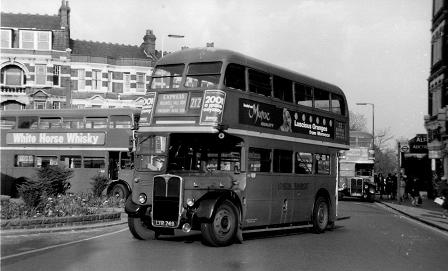 Route
212
Route
212
In complete contrast to the 134, the 212
was a "stand alone" route with no help from any other service. It
was a busy route all day but especially in the peaks when it was
very unusual not to have three bell loads particularly between
Crouch End Broadway and Finsbury Park.
RT2765 working MH12 on
the 212 Express turns onto the stand at Muswell Hill
Broadway, having set down at the final stop where another
212 has already arrived. A third departs back down the hill,
whilst RM1975 from J is on a 134 short. This shot
was probably taken in 1967 after the schedules changed on the last
day of 1966.
Photo Jeff Lloyd
collection
When I arrived the route was RT operated
Mon-Sat and RM from the 43 allocation on Sundays. On weekdays the
run out was easy to remember MH1-MH9 ran the all day service,
MH10-MH14 were the peak hour extras, often turning short at Crouch
End Broadway from Finsbury Park to give the passengers
there an empty bus to clear the queues. MH15-MH18 were the 212
expresses with blue blinds stopping only at Crouch End
Broadway and Alexandra Park Victoria.
The layover at Finsbury Park was only 1 or
2 minutes. The layover at Muswell Hill Broadway was always
longer to allow for tea and a quick roll up fag. I like the
picture at the heading to your 212 page.
As you can see there were two lanes in the turning circle, which
extended both east and west with the canteen in the centre.
The west side was for the 212 and the east side for the 244 and
short workings on the 43/134. There were strict rules. In the
peaks, the outer lane on the east side was for the 212 express
only. Your picture must have been taken off peak as RF 352 doesn't
seem to be on an express working. On the other side the inner lane
was for the 244 and the outer lane for the short working 43 and
134.
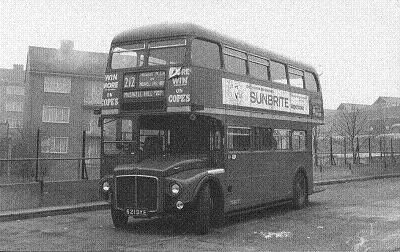 Some
drivers loved the route as it was local with no trips into the City
(43) or the West End (134) but the conductors hated it as all the
passengers were rabbits, the garage word for short-hop riders and
they were kept busy all through the duty. There were the odd
exceptions. I remember a conductor called George who was a complete
masochist who loved to get slaughtered with constant three-bell
loads and he was happy when the bus in front was missing and we
were working a double headway.
Some
drivers loved the route as it was local with no trips into the City
(43) or the West End (134) but the conductors hated it as all the
passengers were rabbits, the garage word for short-hop riders and
they were kept busy all through the duty. There were the odd
exceptions. I remember a conductor called George who was a complete
masochist who loved to get slaughtered with constant three-bell
loads and he was happy when the bus in front was missing and we
were working a double headway.
RM1621 in original condition at Muswell Hill
garage having run in off the 212. Note the RFs in the
background.
Photo Ian Armstrong collection
By mutual consent with the drivers and the
engineering staff, there was a banned list for the 212 because the
service had to have the best RTs. The banned list at the time
was 477, 882, 2905, 4141 and 4804 - they were only allowed on the
134 or 244. It's only fair to balance the books and
give credit to the really good ones - taking 1964 as the base, then
the best RTs to drive were 378, 712, 949, 2235, 2621, 3308, 3780,
4278 and 4560, with 4278 best of all.
The problem with the 212 rota was there was
no variety. On the 43 you got out to Chingford Royal Forest
Hotel on Sundays on the 102 and better still occasionally to
High Beach. I think on summer Sundays about 1 bus in 3 went to High
Beach so there was no guarantee your duty would include one of
those trips. The High Beach extension was withdrawn for
good at the end of 1964 so I was lucky I just got there
in time. On the 210 rota you got the longer trips over the 236 on
Sundays and on the 134 you got the Sunday only 134A. By
the way, GM garage canteen was generally thought to be the
best in the Central Area so the layover there was always enjoyable.
On the 244 most Sunday duties were on the 210 to allow for the more
frequent service.
The last bus from Finsbury Park in the
early hours was MH9 and the checker at Wells Terrace had to keep in
touch with the Station Foreman; the all clear to leave was given
only when the last Piccadilly line train from the West End had
passed through. At this time of course the Victoria Line had not
opened.
The route was never the same when the
Merlins arrived and OPO began with the W7. We actually looked back
happily to the days when passengers were hanging off the rear
platform of the RT as it was almost impossible for the conductors
to control the number of standing passengers.
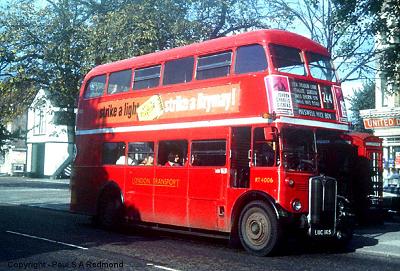
Route 244
And finally a few memories of the 244. My experience
of the 244 was limited to overtime and rest day working and unlike
other routes you had to be careful not to run early as the service
was timetabled. Early running on the 134 and 43 was something
the checkers turned a blind eye to as it was highly likely you
would get delayed somewhere along the route so you could bank some
time in advance. Timings on the 210 and 212 were tight so it wasn't
really an issue.
Perhaps RT4006 is waiting time... Running
south as MH5 to Muswell Hill Broadway, this shot reminds us of
more peaceful days, red telephone boxes and United Dairies
shops.
Photo © Paul Redmond
Before I arrived the garage had just lost the 251 to EW. All the senior drivers approaching
retirement had worked on the 251 rota. To allow them to stay on a
quiet route they were transferred to the 244 and there was a
general reorganisation. Newcomers to the garage always began on the
134 rota.
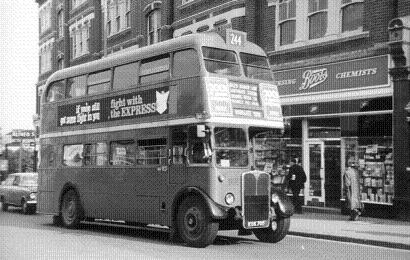 You would
imagine the first bus out in the morning might have been a 43. In
fact it was MH1 on the 244. This early journey was for the benefit
of the night staff at the Highlands Hospital coming off duty and in
fact this first journey terminated there and returned to Muswell
Hill Broadway. This left before the staff bus arrived (see
above), so that was the only duty where you had to walk like it or
not. Very often the crew scheduled for that duty would swap
it with a crew who lived very close to the garage
You would
imagine the first bus out in the morning might have been a 43. In
fact it was MH1 on the 244. This early journey was for the benefit
of the night staff at the Highlands Hospital coming off duty and in
fact this first journey terminated there and returned to Muswell
Hill Broadway. This left before the staff bus arrived (see
above), so that was the only duty where you had to walk like it or
not. Very often the crew scheduled for that duty would swap
it with a crew who lived very close to the garage
The busy time was in the peaks when the service was extended to
Archway to provide much needed help on that busy corridor.
Saunders-bodied RT1236 has
turned round the island at Muswell Hill and heads for Highgate
Archway Station on the rush hour extension of the 244.
Photo Ian Armstrong
collection